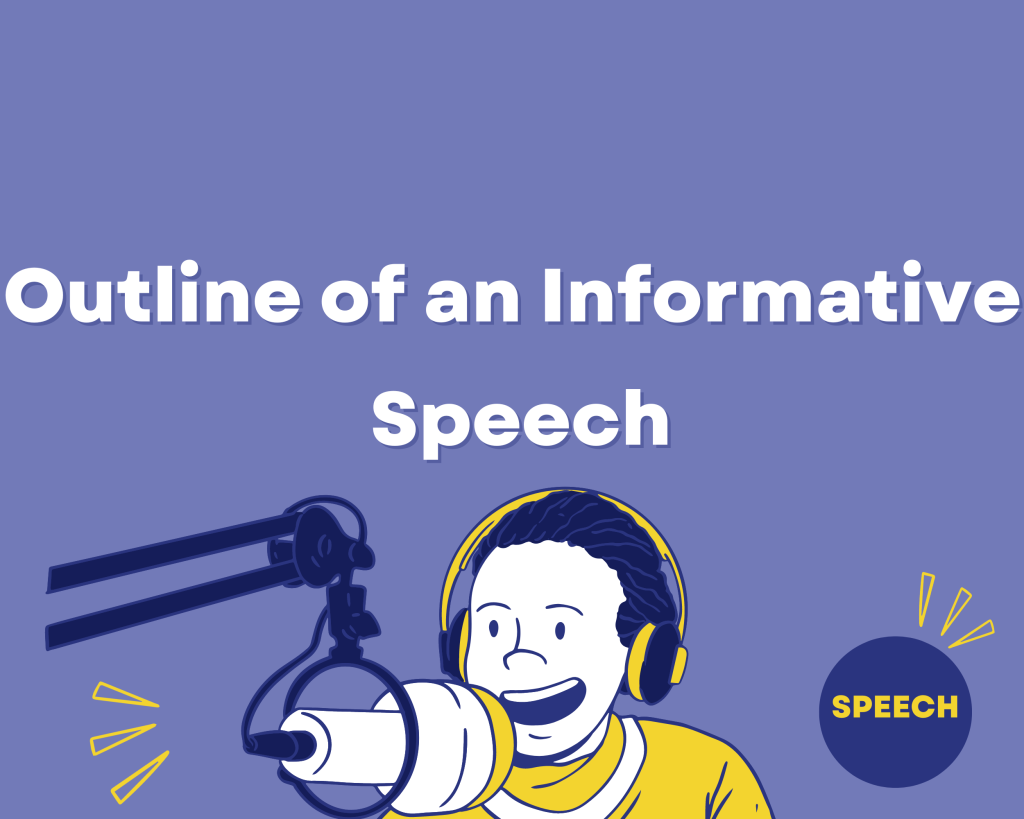Informative speaking is still relatively young in public speaking, an art ancient thinkers like Aristotle, Cicero, and Quintilian viewed as rhetoric and intrinsically persuasive. Humans naturally educate each other through informative speeches. An outline of an informative speech helps the orator to strategize and execute their ideas harmoniously with a flow. Our essay writing experts have developed this guide to elaborate more on an informative speech, how to write it, and an example of an outline of an informative speech. They also assist learners in completing their informative speech essay assignments.
What is an Informative Speech?
An instructive speech aims to educate and inform the audience about a particular subject of discussion. It is typically employed to inform a crowd on a particular subject of interest. The four primary categories of informative talks are descriptive, explanatory, demonstrative, and definition presentations. An instructive speech’s subjects should advance audience comprehension of the subject of interest and aid long-term memory retention.
An informative speech aims to inform rather than persuade or sway the audience to the speaker’s point of view. The specifics must be presented to enable the audience to make an informed choice or learn more about a topic of interest. The speaker must consider how they will convey the information to the audience.
What is an Outline of an Informative Speech
It follows a similar pattern to an informative essay. Two alternative formats exist for outlining speeches: the entire phrase format and the main points approach. Include whole sentences in the outline to assess the speech’s structure and content. Jot down the important points that will assist you in remembering what should be included in your speech when using the key points style blueprint. These two sorts of outlines are used in all speech forms. Depending on your comfort level, you can select any outlining format.
How to Write Outline of an Informative Speech
Writing an effective speech needs relevant materials and a comprehensive understanding of the subject. Before giving an informative speech, it is a good idea to organize and order the information to be presented logically. This will also guarantee that you don’t veer off subject or omit essential details when you deliver your speech.
You can create an excellent informative outline using the fundamental approaches and tips.
Pick a Novel Topic
A topic is the first thing you need for a speech. Pick interesting, new topics for informative speeches that have the potential to be persuasive. Don’t choose a subject that is well-known to the audience. Instead, choose a novel subject about which the audience knows very little.
You could discuss the development of yoga or how to do a specific form. The easier and better you can target your audience, the more particular your speech topic should be.
Conduct Research
Before giving a speech, you should be completely knowledgeable about the subject. You must conduct in-depth research and gather reliable data necessary for the audience to comprehend the speech’s theme.
Organize your information
You can give a persuasive speech now that you have the necessary knowledge. You may keep your speech’s logical flow by using the organizational framework. Three key components make up the basic framework of a speech.
- Introduction
The introduction is an important speech component that seeks to engage the audience. You should mention the following in your introduction:
- Open with an attention-grabbing hook sentence.
- Give the audience a brief overview of the speech’s topic to tell them what you want to discuss.
- Outline a compelling thesis statement to encourage the audience to pay attention to you.
- What qualifies you as an authority on the subject at hand? Justify your authority for bringing up the subject.
- An overview of your speech’s main ideas.
- Body
You can go into more depth on the specific subject of your speech in the body section. The following are the components you must have in the body section:
- Go over the opening ideas of your speech.
- Give illustrations to help your audience comprehend the topic and the information you have presented.
- Flow naturally into your speech’s next major theme.
- Conclusion
The importance of the conclusion was equal to that of the introduction section. Strong conclusions contain the following components:
- Reiterate the important thesis statement and let your audience know your speech’s focus in step one.
- Give a summary of the main key points
- Create a clever conclusion that gives the speech a sense of closure.
By following these simple guidelines, you may create an engaging outline of an informative speech that covers the subject in detail. Here is an example of an informative speech outline to assist you better in understanding how to write one.
Sample Outline of an Informative Speech
You can better arrange your thoughts and material to communicate with your audience by developing an outline of an informative speech. A carefully thought-out outline will guarantee that all the crucial information is included in your speech and that you stay on topic.
An example of an Outline of an Informative speech should have the following:
Topic: Your speech title will be the topic.
Purpose: To educate the audience on the subject matter.
Thesis: A concise summary of the issue and the arguments presented in the presentation serves as the thesis.
- Introduction
- A compelling opening statement
- Justification for hearing the speech
- Thesis statement
- A summary of the topics to be covered
- First Main Point
- First sub-point
- Supporting detail
- Supporting detail
- Second sub-point
- Supporting detail
- Supporting detail
- First sub-point
- Second Main Point
- First sub-point
- Supporting detail
- Supporting detail
- Second sub-point
- Supporting detail
- Supporting detail
- First sub-point
- Third main point
- First sub-point
- Supporting detail
- Supporting detail
- Second sub-point
- Supporting detail
- Supporting detail
- First sub-point
- Conclusion
- Restatement of main points
- Restatement of thesis
- Concluding remarks
- Restatement of main points
To write an effective speech, adhere to the following guidelines when creating an outline:
- Each point, sub-point, and supporting detail should have one idea.
- There must be a second point if there is only one. There should be a second supporting point if there is just one.
- Be dependable. Use whole sentences throughout the blueprint if you’re describing points and sub-points using them. Consistent verb tenses should be used throughout your outline.
Get Online Assistance with Writing an Essay
An outline is the building block of any type of writing. The outline of an informative speech should assist you in creating an excellent speech or an essay. Contact us if you require help or want to hire someone to write your essay. You can ask for our online essay writing assignment help by filling out the order form with your specifications.




